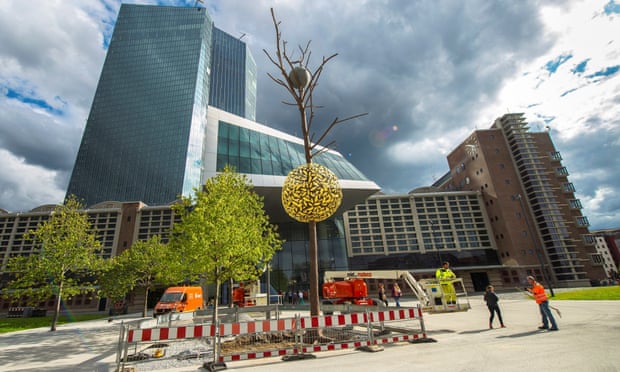The European Central Bank has installed a towering bronze and granite tree sculpture outside the bank’s Frankfurt headquarters as part of a €1.25m (£920,000) art project.
The work by Italian artist Giuseppe Penone, instantly dubbed the magic money tree, is a slender trunk with a perfectly round ball of gilded leaves at its halfway point. Something that looks like a faded beach ball is lodged among the barren upper branches.
Loosely modelled on a walnut tree, it stands 17.5 metres tall – soaring above real chestnut trees at the entrance to the ECB headquarters, a billion-euro building that opened to scenes of protest from anti-austerity campaigners earlier this year.

The work is called Gravity and Growth. Although this could be a nod to powerful forces that have weighed on eurozone growth, the ECB had a different explanation.
“Giuseppe Penone’s tree conveys a sense of stability and growth and is rooted in the humanist values of Europe in the most beautiful way,” said Benoît Cœuré, the ECB executive board member who chaired the art jury that selected the work from a longlist of almost 60 European artists.
For ECB watchers, the work is a rich symbol for a central bank that conjures up €60bn each month to nurture the stunted economy of the eurozone back to health.
Mario Draghi, the ECB president, who has led the ECB’s €1.1tn magic money programme, better known as government bond-buying, or quantitative easing, will formally unveil the artwork at a ceremony on 6 October.
The money tree is one of three artworks costing €1.25m that have been specially commissioned for the ECB headquarters. An aluminium stone by Bulgarian artist Nedko Solakov has already been installed inside an atrium, while a sculpture of a mathematical formula by 2002 Turner prize nominee Liam Gillick will be hoisted on to the roof of the ECB conference hall later this month.
Aside from these works, the ECB spends about €140,000 on art each year and its collection includes pieces by contemporary artists, such as the Dutch photographer Anton Corbijn and French-Algerian artist Fayçal Baghriche.
“It is not about decorating the headquarters, it is about helping the cultural world,” a spokeswoman said, citing European Union treaty article 167, which states that the union will contribute to “the flowering of the cultures of the member states”.
She added: “Public institutions in many countries have the obligation, or are encouraged by guiding principles, to commission works of art when they construct a new building.
“In times of austerity we think it is important to spend money on art because it is a unifying theme between countries.”
Paradoxically, the artwork most associated with the ECB – the giant sculpture of the euro sign outside its old headquarters – was never part of the central bank’s art collection, but belongs to a Frankfurt nonprofit foundation.
In a stroke of unhappy timing, that euro was dismantled in early July as the Greek debt crisis was raging. The blue and gold structure reappeared after two days’ renovation – a far quicker fix than solving the problems of the currency union.


































